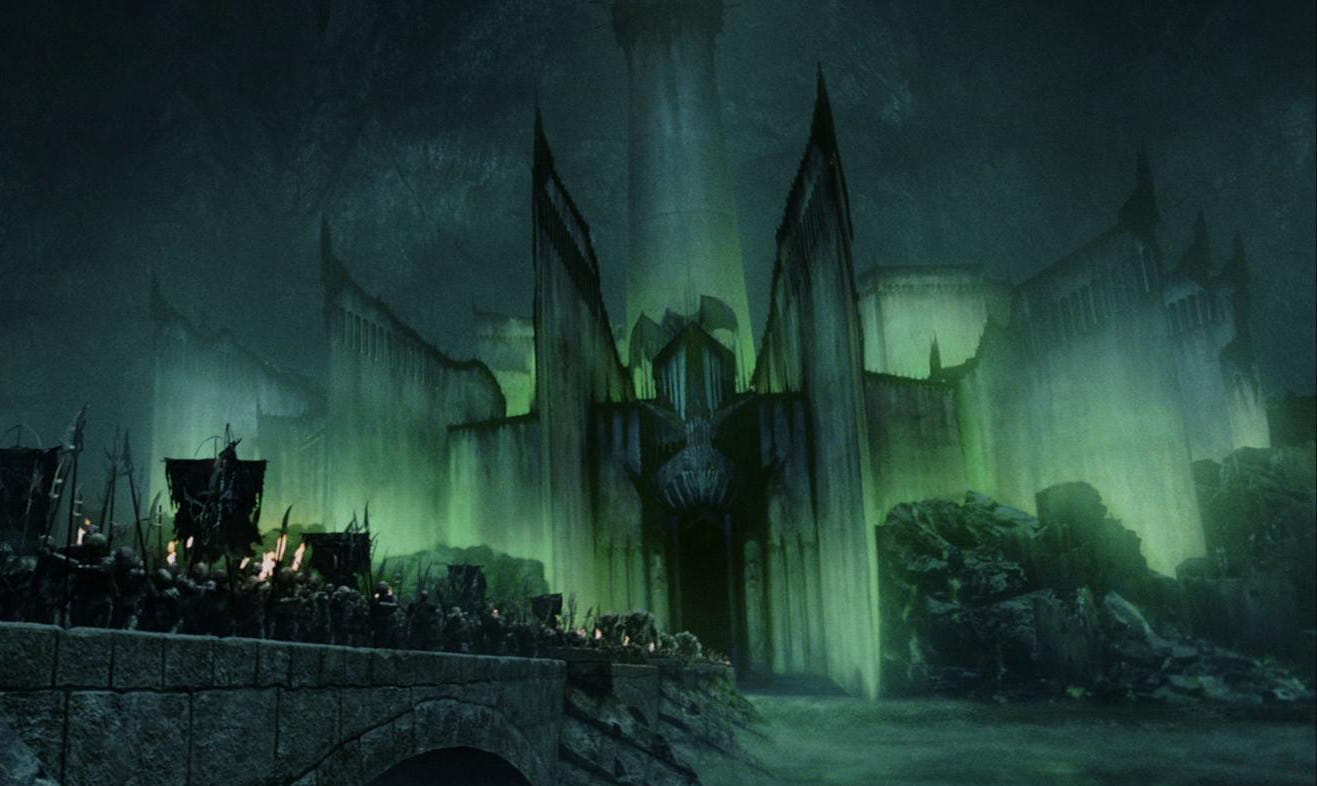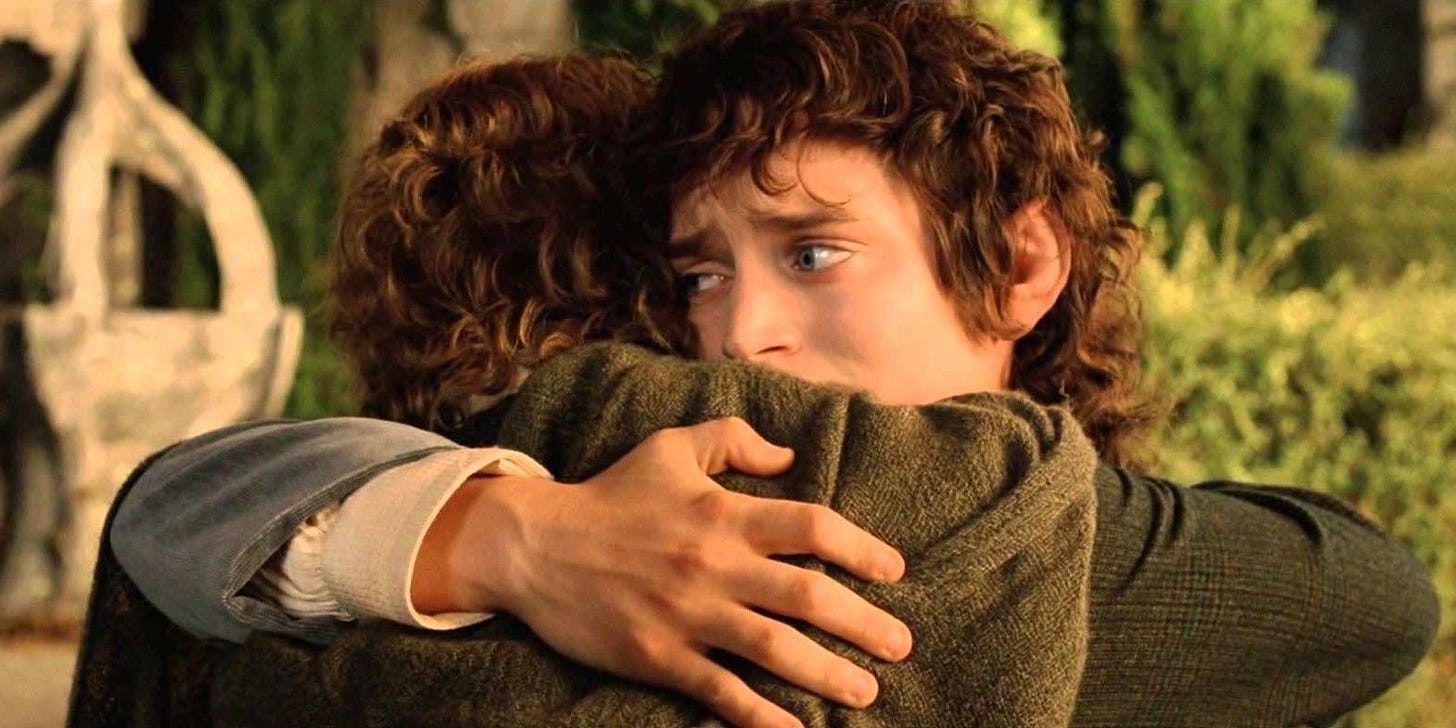When I embarked on this latest rewatch, I was worried that the three Lord of the Rings films would not stand on their own merits—that they would lack distinct tones or structure. If you’ve read my previous two essays, you know that fear was swept away deep into a hobbit hole. Fellowship of the Ring was a slapstick horror, while Two Towers was a staid historical war epic. So what is Return of the King? Well, imagine you’re having some stew at Bag End—and Bilbo adds just the perfect amount of each prior film to the pot: a bit of campy horror…a splash of historical drama…followed by a dash of Peter Jackson’s next film: my beloved King Kong.
The most surprising aspect of Return of the King isn’t its multiple (and completely earned) endings—it’s the number of gnarly beasties on screen. We’ve got subspecies of trolls, Nazgûl fell beasts, big spiders, giant rhinos, and kaiju-sized elephants! Hell, even my enemy Gollum looks better this time around. The artists and designers at Wētā Workshop were so talented at creating monsters, that it’s no wonder that Jackson's next project boiled down to “let’s just fill an island with these bastards.” I’m sure I’ll write more about King Kong another day, but beyond the structural and storytelling similarities, these zoologically-minded films use their creatures to embrace the excitement of fantasy and the camaraderie of facing the unimaginable.
Picking up in the aftermath of Two Towers, Return of the King uses its 250-minute runtime to recount the final days of the Third Age. Characters we love are reunited, separated by sudden oaths (Pippin what are you doin’, man) or desperate strategy, only to be reunited at the end of the world. Aragorn, Gimli, and Legolas (Viggo Mortensen, John Rhys-Davies, and Orlando Bloom) seek a hail-mary weapon within the haunted mountains. Pippin and Gandalf (Billy Boyd and Ian McKellen) head to Minas Tirith on the eve of war, while Merry (Dominic Monaghan) becomes an esquire of Rohan. Finally, Frodo and Sam (Elijah Wood and Sean Astin) make their final ascent toward Mount Doom.
Talking with friends about the trilogy over the last few months, it feels like Return of the King generally holds a lesser place in the hearts of fans. Perhaps it’s the extreme length, or the natural burden of being the conclusion, but it’s often reduced to being “the one with all the battles” or “the one for the bros.” The former is partially true—in addition to a handful of smaller skirmishes, ROTK boasts the Battle of Osgiliath, the Battle of Pelennor Fields, and the Battle of the Black Gate. However, on this rewatch, I found them to be invigorating! I wrote at length about my problems with Two Towers last time, but even a sequence as critically adored as Helm’s Deep left me cold with its drab historical-fiction tone. The orcs may as well be another army of humans—just with a more mud-based ideology. In contrast, the beast-heavy warfare of ROTK lets its fantasy flag fly. Now, I’m not purely pro-monster—this year hasn’t quite devolved me into someone who watches Monarch: Legacy of Monsters—but Jackson’s direction and Wētā Workshop’s creature design allow for the beasts of Middle-earth to bring forth that je ne sais quoi juice I talked about in my Fellowship essay. By shooting the Nazgûl fell beasts from below like horrendous carrion birds, or using a handheld camera while a nightmarish troll chases civilians through a narrow city street, Jackson not only establishes a respect for the series’ fantasy roots, but a bottom-of-the-food chain fear that brings to mind the much-loved horror elements of the first film. Even the god-like Mûmakil, elephants the size of Godzilla, should be silly—but Jackson’s Attack on Titan introduction of them on the horizon (paired with Bernard Hill’s look of “you gotta be fuckin’ me”) drops my heart into my guts. One of my favorite scenes in the film happens quite early, as Gollum leads Frodo and Sam past the maw of Minas Morgul. Jackson shoots this sequence like an expressionist horror, with leering gargoyles wagging their tongues from neon green bastions, and the Witch King of Angmar erupting from its peak like Chernabog from Night on Bald Mountain. As touched on in my first essay, this reliance on horror imagery opens up ROTK’s bleeding-heart-earnestness to the audience, while also grounding these CGI beasties in fear rather than pure spectacle.
In the shadow of this tidal wave of monsters, ROTK finds its heart among the little people of Middle-earth—and I’m not just talkin’ Tooks. Side characters are given spotlights even outside the bounds of extended edition scenes, reminding us of why we love these old friends (and new). For example, the opening hour gifts the audience multiple scenes of characters just hanging outside for a smoke or reveling in drink. Legolas and Gimli have often had the short shrift throughout the trilogy–reduced to pure comedic relief or just shouting out wild exposition on horseback. They’re not exactly gifted monologues, but Legolas’s smoke break with Aragorn is a welcome chat among friends, and Gimli crooning over “little hairy women” like a drunk Orson Welles is a pure serotonin rush. Minor characters introduced in Two Towers like Éowyn (Miranda Otto) or Faramir (David Wenham) are able to shake off the stuffiness of the second entry and find their own footing—often via proximity to Merry or Pippen. Merry and Pippen were already my favorite characters of the trilogy, but their heart-wrenching separation after Pippen’s peek into the Palantir widens the scope to explore the last two human civilizations’ march toward doom. I have a soft spot for Faramir’s tale, as his band of Gondorion Rangers feel like a faction ripped straight from D&D or any other fantasy RPG. As well, the tragedy of his brother Boromir’s death introduces the Steward of Schlubs. If there was a Geiger counter for schlubiness, Denethor (John Noble), the Steward of Gondor, would light up like Chernobyl. Bundled in filthy white coats, Denethor is cold inside and out—shriveled and cracked upon his stunted throne. Aside from his legendary tomato-eating skills, Denethor serves as the human antagonist—a grief-ridden figurehead whose cruelty teaches Pippen to swear his loyalty to people rather than faded institutions.
That loyalty and love is what allows our heroes to survive such terrifying odds. Éowyn, the ferocious shield-maiden of Rohan, was saddled with a non-starter of a romance plotline in Two Towers. Separated from Aragorn, she can put away any modesty or unrequited pining and become the warrior she was meant to be. Before her duel with the Witch King (arguably the sickest fight in the entire trilogy), Éowyn wanders the lonely camps of Rohan’s army with Merry—ruminating on the certain death that awaits. “I know I can’t save Middle-earth,” says Merry, “I just want to help my friends.” The thing is, those are the exact same thing. Sam and Frodo’s journey is the ultimate testament to this—by staying true to one another, they’re able to save the world. In my first essay on Fellowship, I marveled at how simple and captivating Jackson and his team made this fantasy world seem compared to the countless others that waste into obscurity. At the end of this journey, it’s pretty simple to see why. It’s why people in your D&D group remember the inside jokes and not the names of whatever kingdoms you made up. It’s why there are five endings dedicated to reuniting the fellowship. It’s why at the Battle of the Black Gate, when Aragorn charges into the darkness of death, his rallying cry isn’t “for Gondor.”
It’s for Frodo.
That’s the end of Schlub Madness! Thank you for reading these pieces (yes, you!) Whether you’ve been here since the beginning, or are just stopping through, it means the world to me! Obviously, it was not ideal for March Madness to last until October, but I’m proud to share these essays on such a titanic franchise.
Looking ahead, expect another essay around November, as well as an update on what to expect in 2025 (merch??)
The Lord of the Rings: The Return of the King is streaming on HBO MAX and is available to rent on most streaming platforms.
Special thanks to Austin Smoldt-Sáenz, Elena Bruess, Joshua De Lanoit, Claire Rogers, and Max Seifert.






